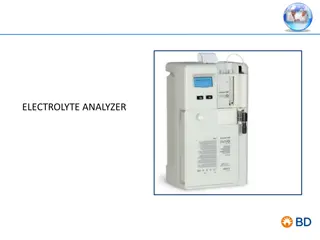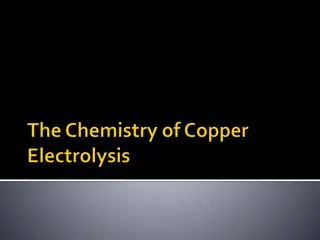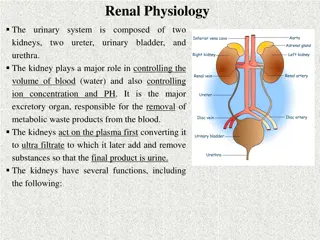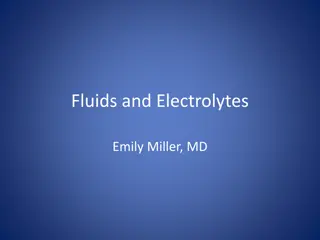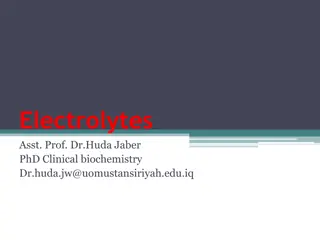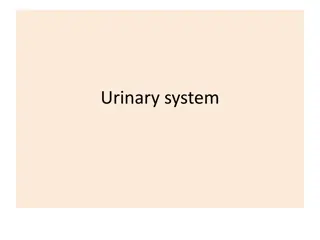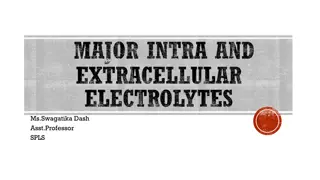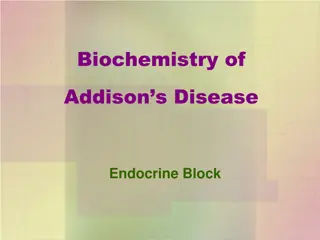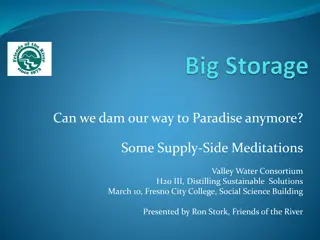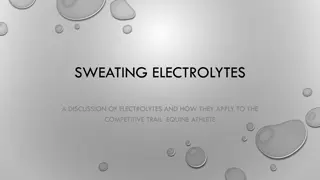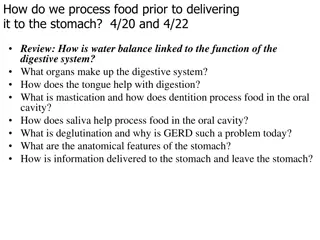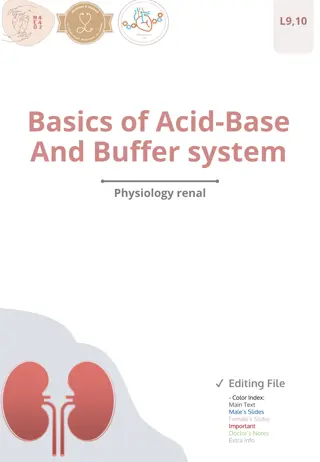Understanding Water and Electrolyte Balance in the Human Body
The body's fluid compartments, including intracellular and extracellular fluids, play a crucial role in maintaining water and electrolyte balance. This balance is regulated by movements of water and electrolytes between compartments, influenced by factors like hydrostatic and osmotic pressures. Maintaining proper water balance is essential for overall health, with water intake coming from various sources like drinking, food, and metabolic processes. Even a small water loss can trigger thirst mechanisms to regulate water intake.
Uploaded on Sep 07, 2024 | 2 Views
Download Presentation

Please find below an Image/Link to download the presentation.
The content on the website is provided AS IS for your information and personal use only. It may not be sold, licensed, or shared on other websites without obtaining consent from the author. Download presentation by click this link. If you encounter any issues during the download, it is possible that the publisher has removed the file from their server.
E N D
Presentation Transcript
Water and electrolyte Water and electrolyte balance balance DR. PRASHANT D. CHANDEKAR ASSO. PROFESSOR SMT. VIMLADEVI AYURVED COLLEGE CHANDRAPUR
Distribution of body fluid body fluids are not uniformly distributed they are coupe compartments of different volumes that contain wearing composition . Water and electrolyte movements between these compartments is regulated to stabilize their distribution and the composition of body fluids.
Flute compartment In adult 40 litres About two third is intracellular fluid About one-third is extracellular fluid In adult female about 52% of body weight In adult male about 63% of body weight
Body fluid composition extracellular fruits are generally similar in composition including high concentration of sodium calcium chloride and bicarbonate ion intracellular fluids have high concentration of potassium magnesium phosphate and sulphate ion.
Movements of loot between compartment hydrostatic pressure and osmotic pressure are two major factors that regulate the movements of water and electrolyte from one fluid compartment to another. flute leaves plasma at arteriolar ine of capillaries because how to work force of hydrostatic pressure predominates. flute returns to plasma at vennila end of capillaries because in workforce up ko light osmotic pressure predominates. Hydrostatic pressure within interstitial space forces fluid into lymph capillaries. Interstitial fluid is in equilibrium with extracellular and intracellular fluid.
Water balance Water balance Watermelon suggestive in water intake equal water or photo messages require controller but water intake converter output. water intake the volume of water gained is day where is among individual. . 60% from drinking. 30% from my food. 10% as a byproduct of oxidative metabolism of nutrient called water of metabolism.
Regulation of water intake If the body loses as little as 1% of its water An increase in the cosmetic pressure of extracellular flude due to water loss stimulated asthma receptor in the third centre. Activity in hypothalamus causes person to feel thirsty and drink water. Drinking and the resulting distension of the stomach by water stimulate now impulse says that inhibit the third centre. Water is absorbed through the wall of the stomach and small intestine. The osmotic pressure of extracellular fluid returns to normal.
Water output Water output Water normally enter the body only through the mouth but it can be lost by a variety of fruits including. Urine 60% loss Fishes 6% loss Sweat 6% loss Evaporation from skin and lungs 28% loss
Regulation of water output India hydration condition Extracellular fluid becomes as matakali more concentrate. asthma receptor in the hydra thalamus are stimulated by the increase in the asthmatic pressure of body fluid. due to the hypothalamus signals the posterior pituitary gland to release head ears into the blood. Blood carries a DH to the kidney. AIDS causes the distal convoluted tubules and collecting ducts to increase water reabsorption. Urine output decreases and for the water loss in minimised.
In excess water intake She play extra cellular applaud become has medically place concentrate. this this change stimulated osmoreceptors in hypothalamus. The posterior pituitary gland decreases ADH release. Renal tubules decreases water reabsorption. Urine output increases and excess water x-rated.
Electrolyte intake Electrolyte intake The electrolytes are greatest importance to the cellular functions and these are sodium, potassium, calcium, magnesium, chloride, sulphate, phosphate, bicarbonate and hydrogen ions. These electrolytes are primarily obtained from foods but some are from water.
Regulation of electrolyte intake. Regulation of electrolyte intake. Ordinarily a person obtain sufficient electro light by responding to hunger and thirst .severe electrolyte deficiency may cause salt craving.
Electrolyte output Electrolyte output The body loses some electrolyte by pursuing typically on warmer days and during strenuous exercise. Some are lost in the feces. The greatest output is as a result of kidney function and urine output.
Regulation of electrolyte output Regulation of electrolyte output the concentration of positively charged ions such as sodium,(Na+) potassium (K) and calcium (Ca) are of particular importance these ions are vital for nerve impulse conduction muscle fiber contraction and maintenance of cell membrane permeability



